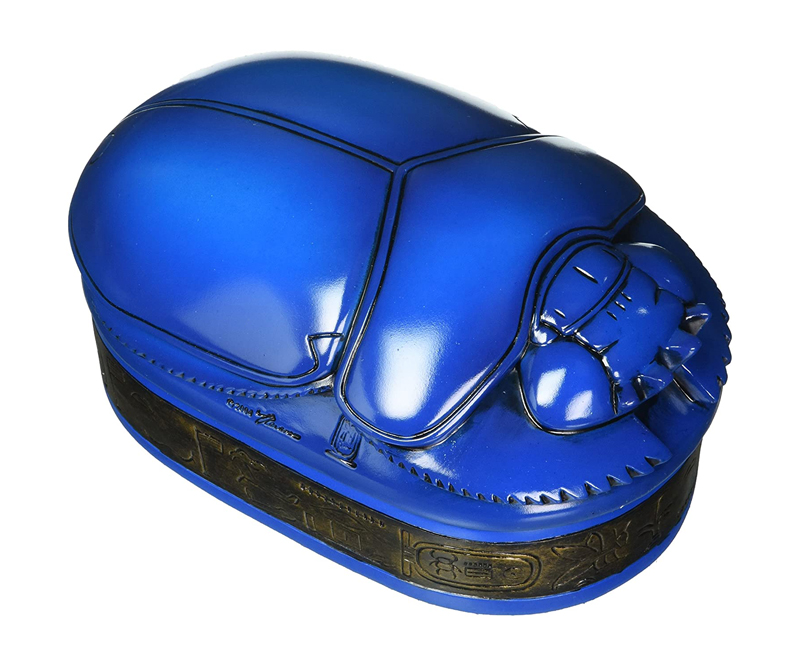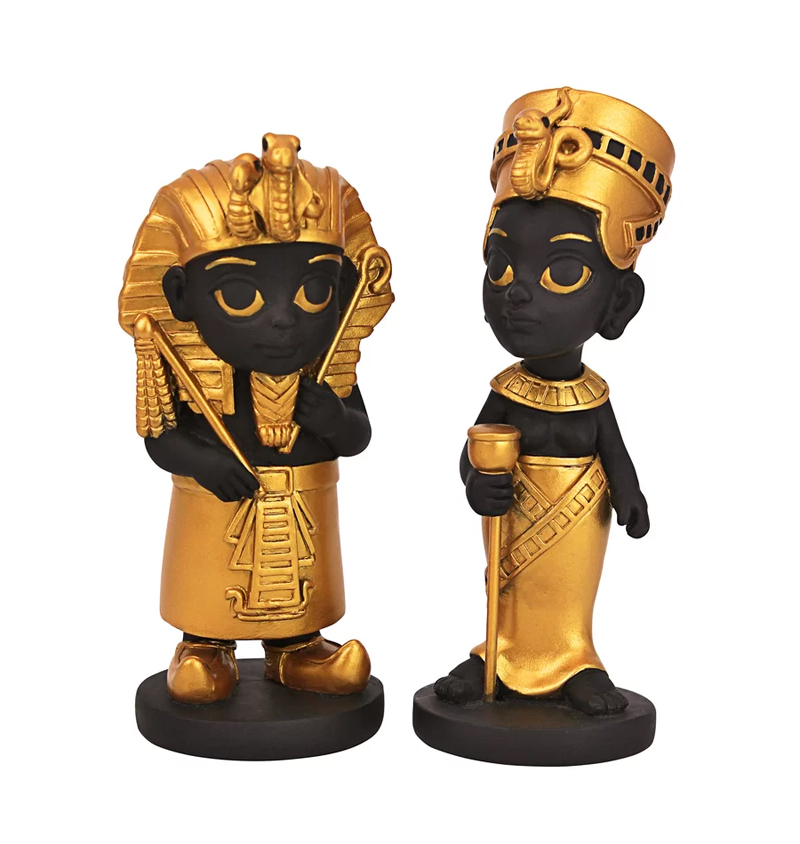Egyptian Pharaoh Amenhotep III Royal Scarab Statue
Amenhotep III Royal Scarab Statue, finished in faux lapis lazuli blue, creates the liftable lid of this sculptural jewelry box, complete with ancient hieroglyphs written in gold along the edge, to store all your Egyptian jewelry as how it was done for the Gods and Egyptian Queen. Hand-cast using real crushed stone bonded with durable designer resin, this Egyptian Royal Scarab include fine details such as Egyptian hieroglyphs which are painted by hand. Amenhotep III commissioned many commemorative scarabs to be sent as royal gifts that marked the accomplishments of his Egyptian dynasty. Scarab Beetles were prized because they mirrored the way the Egyptian Sun God Khepri was said to roll the sun across the horizon each day. This Amenhotep III Royal Scarab replica artifact is sculpted with a beetle’s head, wing case and legs, all in a beautifully compact form. The entire Egyptian sculptural box, including the liftable lid, is cast in quality designer resin and hand painted to replicate the faience earthenware and glazed blue lapis once highly prized by Egyptian royalty.
The Scarab Beetle, representing rebirth, was a popular image used in ancient Egypt as an amulet or seal to be worn as Egyptian jewelry or to commemorate an event such as those made by Pharaoh Amenhotep III. Amenhotep III, “Amun is Satisfied“, hellenized as Amenophis III, also known as Amenhotep the Magnificent or Amenhotep the Great, was the 9th pharaoh of the 18th Dynasty. According to different authors, he ruled Egypt from June 1386 to 1349 BC, or from June 1388 BC to December 1351/1350 BC, after his father Thutmose IV died. Amenhotep III was Thutmose’s son by a minor wife, Mutemwiya. His reign was a period of unprecedented prosperity and splendour, when Egypt reached the peak of its artistic and international power. When he died in the 38th or 39th year of his reign, his son initially ruled as Amenhotep IV, but then changed his own royal name to Akhenaten.
Scarabs instead were popular amulets and impression seals in Ancient Egypt. They survive in large numbers and, through their inscriptions and typology, they are an important source of information for archaeologists and historians of the ancient world. They also represent a significant body of ancient art. For reasons that are not clear (although likely connected to the religious significance of the Egyptian God Khepri), amulets in the form of Scarab Beetles had become enormously popular in Ancient Egypt by the early Middle Kingdom (2000 BCE) and remained popular for the rest of the pharaonic period and beyond. During that long period the function of scarabs repeatedly changed. Primarily amulets, they were also inscribed for use as personal or administrative seals or were incorporated into jewelry. Some scarabs were created for political or diplomatic purposes to commemorate or advertise royal achievements.
By the early New Kingdom, Heart Scarabs had become part of the battery of amulets protecting mummies. From the Middle Bronze Age, other ancient peoples of the Mediterranean and the Middle East imported scarabs from Egypt and also produced scarabs in Egyptian or local styles, especially in the Levant. In ancient Egyptian religion, the God Ra is seen as the star Sirius, when the star came to the horizon in the south 15 thousand years ago. Beetles of the family Scarabaeidae (dung beetle) roll dung into a ball. Because of its symbolically similar action, the scarab was seen as a reflection of the precession cycle of the star Sirius and as representing the idea of rebirth or regeneration on its swing in the south as it was viewed. Egyptian Pharaoh Amenhotep III Royal Scarab Statue sizes: 3.5 inches / 9 cm x 5.5 inches / 14 cm x 3 inches / 7.5 cm.
Amenhotep III Royal Scarab Statue on Amazon.
Amenhotep III Royal Scarab Statue on eBay.
Animals Statues, Scarabs Statues, Egyptian Statues and Symbolic Statues.





You must be logged in to post a comment.